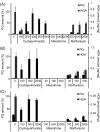Action mechanism of bleaching herbicide cyclopyrimorate, a novel homogentisate solanesyltransferase inhibitor
- PMID: 30479543
- PMCID: PMC6240781
- DOI: 10.1584/jpestics.D18-008
Action mechanism of bleaching herbicide cyclopyrimorate, a novel homogentisate solanesyltransferase inhibitor
Abstract
The action mechanism of cyclopyrimorate, a novel herbicide for weed control in rice fields, was investigated. Cyclopyrimorate caused bleaching symptoms in Arabidopsis thaliana similar to those caused by existing carotenoid biosynthesis inhibitors, mesotrione and norflurazon. However, cyclopyrimorate treatment resulted in significant accumulation of homogentisate and a reduction in the level of plastoquinone. A metabolite of cyclopyrimorate, des-morpholinocarbonyl cyclopyrimorate (DMC), was detected in plants. These data suggested that cyclopyrimorate and/or DMC inhibit homogentisate solanesyltransferase (HST), a downstream enzyme of 4-hydroxyphenylpyruvate dioxygenase in the plastoquinone biosynthesis pathway. In vitro assays showed that A. thaliana HST was strongly inhibited by DMC and weakly by cyclopyrimorate, whereas other commercial bleaching herbicides did not inhibit HST. DMC derivatives showed a positive correlation between HST inhibition and in vivo bleaching activities. These results indicate that the target site of cyclopyrimorate and DMC is HST, a novel target site of commercial herbicides.
Keywords: bleaching herbicide; carotenoid biosynthesis inhibitor; cyclopyrimorate; homogentisate solanesyltransferase; plastoquinone biosynthesis inhibitor.
Figures






Similar articles
-
Expression, purification, and characterization of transmembrane protein homogentisate solanesyltransferase.Appl Microbiol Biotechnol. 2024 Mar 7;108(1):256. doi: 10.1007/s00253-024-13094-6. Appl Microbiol Biotechnol. 2024. PMID: 38451307 Free PMC article.
-
In vivo and in vitro evidence for the inhibition of homogentisate solanesyltransferase by cyclopyrimorate.Pest Manag Sci. 2020 Oct;76(10):3389-3394. doi: 10.1002/ps.5698. Epub 2019 Dec 24. Pest Manag Sci. 2020. PMID: 31773889
-
Aclonifen targets solanesyl diphosphate synthase, representing a novel mode of action for herbicides.Pest Manag Sci. 2020 Oct;76(10):3377-3388. doi: 10.1002/ps.5781. Epub 2020 Feb 27. Pest Manag Sci. 2020. PMID: 32034864
-
p-Hydroxyphenylpyruvate dioxygenase inhibitor-resistant plants.Pest Manag Sci. 2005 Mar;61(3):269-76. doi: 10.1002/ps.997. Pest Manag Sci. 2005. PMID: 15633191 Review.
-
4-Hydroxyphenylpyruvate dioxygenase inhibitors in combination with safeners: solutions for modern and sustainable agriculture.Angew Chem Int Ed Engl. 2013 Sep 2;52(36):9388-98. doi: 10.1002/anie.201302365. Epub 2013 Jul 26. Angew Chem Int Ed Engl. 2013. PMID: 23893910 Review.
Cited by
-
Improved herbicide discovery using physico-chemical rules refined by antimalarial library screening.RSC Adv. 2021 Feb 23;11(15):8459-8467. doi: 10.1039/d1ra00914a. eCollection 2021 Feb 23. RSC Adv. 2021. PMID: 35423398 Free PMC article.
-
Inhibition of chloroplast translation as a new target for herbicides.RSC Chem Biol. 2021 Nov 10;3(1):37-43. doi: 10.1039/d1cb00192b. eCollection 2022 Jan 5. RSC Chem Biol. 2021. PMID: 35128407 Free PMC article.
-
Microbial Bioherbicides Based on Cell-Free Phytotoxic Metabolites: Analysis and Perspectives on Their Application in Weed Control as an Innovative Sustainable Solution.Plants (Basel). 2024 Jul 22;13(14):1996. doi: 10.3390/plants13141996. Plants (Basel). 2024. PMID: 39065523 Free PMC article. Review.
-
A Novel mechanism of herbicide action through disruption of pyrimidine biosynthesis.Proc Natl Acad Sci U S A. 2023 Nov 28;120(48):e2313197120. doi: 10.1073/pnas.2313197120. Epub 2023 Nov 21. Proc Natl Acad Sci U S A. 2023. PMID: 37988466 Free PMC article.
-
Expression, purification, and characterization of transmembrane protein homogentisate solanesyltransferase.Appl Microbiol Biotechnol. 2024 Mar 7;108(1):256. doi: 10.1007/s00253-024-13094-6. Appl Microbiol Biotechnol. 2024. PMID: 38451307 Free PMC article.
References
-
- I. Heap: “Integrated Pest Management,” Springer, Netherlands, Chap. 12, pp. 281–301, 2014.
-
- http://www.weedscience.org/ (Accessed 21 Nov., 2017)
-
- S. O. Duke: Pest Manag. Sci. 68, 505–512 (2012). - PubMed
-
- http://hracglobal.com/ (Accessed 21 Nov., 2017)
-
- P. Boger and G. Sandmann: “Target Sites of Herbicide Action,” CRC Press, Boca Raton, FL, pp. 25–44, 1989.
LinkOut - more resources
Full Text Sources
Other Literature Sources
Molecular Biology Databases
